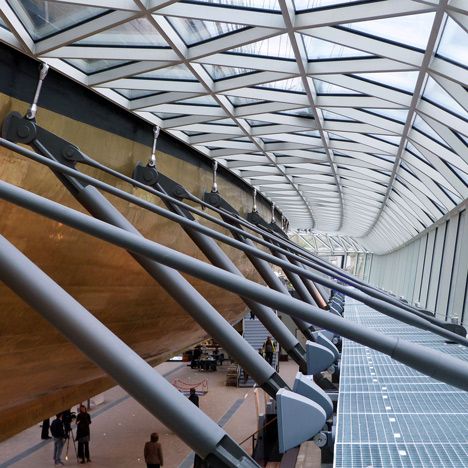Designed by Grimshaw, Cutty Sark epitomizes the great age of sail; she is the last surviving tea clipper. Herre markable story is tangible evidence of the centuries-long importance of sea-trade to this country and to the growth of London as the world’s pre-eminent port and trading center. Built as a tea clipper, where speed to market was critical, it is the combination of sail and hull form which gave Cutty Sarker edge. The hull shape is defined by the revolutionary 19th-century composite iron and timber shipbuilding technique. A comprehensive program of conservation began on Cutty Sark in 2004, which saw the biggest overhaul of the Grade I listed landmark for 50 years with the ship’s reopening planned to take place in 2009. The project was brought to a dramatic halt when a fire in 2007 swept through the wooden structure, causing extensive damage to the center of the ship.  The disaster caught the public’s interest and initiated a major fundraising campaign, enabling the project not only to be resumed at the end of 2009 but to an enhanced design brief. The new design proposed raising the 963 tonnes Cutty Sark three meters within the dry berth. The dry berth was created in the 1950s, and purpose-built in mass concrete on a former bomb site to house Cutty Sark when she was brought to Green-wich from Shadwell Basin. The ship was floated down the Thames and maneuvered into the berth before the end was sealed and the water drained to allow her to Reston the berth’s floor. In order to deliver this new conservation solution, within the constraints of the dry-berth, it demanded that the new intervention had to respect, repair, and adapt to the original fabric of the ship.
The disaster caught the public’s interest and initiated a major fundraising campaign, enabling the project not only to be resumed at the end of 2009 but to an enhanced design brief. The new design proposed raising the 963 tonnes Cutty Sark three meters within the dry berth. The dry berth was created in the 1950s, and purpose-built in mass concrete on a former bomb site to house Cutty Sark when she was brought to Green-wich from Shadwell Basin. The ship was floated down the Thames and maneuvered into the berth before the end was sealed and the water drained to allow her to Reston the berth’s floor. In order to deliver this new conservation solution, within the constraints of the dry-berth, it demanded that the new intervention had to respect, repair, and adapt to the original fabric of the ship.

Project Info:
Architects: Grimshaw
Location: London, England
Partner: Chris Nash
Associate Director: Diane Metcalfe
Project Architects: Jorrin Ten-Have, Den Farnworth
Architect: Joe Laslett
Principal: Steve Brown
Client: The Cutty Sark Trust
Photographs: Jim Stephenson
Project Name: Cutty Sark
















